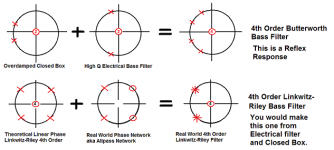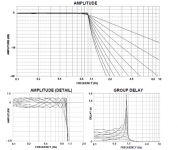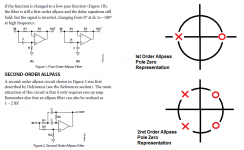rcw: A few forum participants did a DBT on group delay using files created by Malcolm Hawksford. I wouldn't say it was easy and obvious, but at least two of us did sort them properly. For me, the interesting part wasn't that we could hear the differences (I expected that we could), but the heated reaction of the Golden Ear crew, who refused to even try.
With DBT function available in foobar and a few minutes with sound editing software, it's easy for anyone to determine their own sensitivity.
With DBT function available in foobar and a few minutes with sound editing software, it's easy for anyone to determine their own sensitivity.
rcw: A few forum participants did a DBT on group delay using files created by Malcolm Hawksford. I wouldn't say it was easy and obvious, but at least two of us did sort them properly. For me, the interesting part wasn't that we could hear the differences (I expected that we could), but the heated reaction of the Golden Ear crew, who refused to even try.
With DBT function available in foobar and a few minutes with sound editing software, it's easy for anyone to determine their own sensitivity.
SY, I'd like to try that test. Are the files available?
In the latest issue of JAES is an article about the audibility of phase distortion, which is mathematically related to group delay distortion.
Talking about the latter: The name of the thread shouldn't be whether group delay is audible - it should actually be about audibility of group-delay DISTORTION.
Regards
Charles
Talking about the latter: The name of the thread shouldn't be whether group delay is audible - it should actually be about audibility of group-delay DISTORTION.
Regards
Charles
Charles,In the latest issue of JAES is an article about the audibility of phase distortion, which is mathematically related to group delay distortion.
Talking about the latter: The name of the thread shouldn't be whether group delay is audible - it should actually be about audibility of group-delay DISTORTION.
How are "phase distortion" and "group delay distortion" defined?
How are "phase distortion" and "group delay distortion" defined?
The mathematical link between group-delay and phase is that group delay is proportional to the negative slope of the phase versus frequency .
Systems with constant group delay are per se linear phase. I.e. phase-shift is proportional to frequency.
If a system is not linear phase it will not have constant group-delay OTOH. Non - constant group delay means group-delay distortion.
If a system has frequency ranges with rapid phase-changes it even has humps in its group delay.
I made my statement in the former post to indicate that studies dealing with the audibility of phase-distortion can also be indicators for the audibility of groupe-delay distortions to some degree )while pointing to latest study that I know of).
But studies of these things are always difficult to perform and to interprete. Many times one sees citations of the study by Blauert and Laws. IMO credit goes to them for being the first ones dealing with this subject. OTOH it is often cited where it is not applicable IMHO. In their test setup they used a severily bandwith-limited signal (which is therefore having quite some group-delay distortion from the beginning) to which they added peaking group delay distortion with allpass filters. One cannot simply apply their findings to the audibility of group-delay distortion in wideband speakers with crossovers.
My opinion is that it is never bad to keep group-delay distortion as low as possible as long as other parameters are not sacrificed.
Keep in mind that according to information theory a channel with group delay distortion has a lower information capacity than one without group-delay distortion (everything else being equal). But als always in information theory an information channel has to be optimised for matching the source and the sink of the information. If there would exist a mathematical model for the audibility of group-delay distortion it would be easy to design speakers that are blameless* in this respect.
*copyright: D. Self
Regards
Charles
Group delay within pass band causes no loss of information, just changes to phase.
I do not agree with this; if you listen to zero-phase loudspeakers, things like percussion have a different (more real) attack sound.
for instance, a snare drum sounds "tok" instead of "tak".
Therefore I think that information does get lost because of phase distortion.
The downside of multiway speakers which are corrected te be zero-phase, is that the of-axis response becomes worse in the transient response, because of the pre ringing that the correction filters cause.
just my 2 cents..
Kees
edit; of course this is a bit symatic, the information expressed as electrical energy doesn't gest lost. A sine sweep is in this way the same as a single impulse, though they sound rather different..
Last edited:
If there would exist a mathematical model for the audibility of group-delay distortion it would be easy to design speakers that are blameless in this respect.
There is lots of evidence that GD distortion can be audible, and a lot of this evidence says that its audibility increases with increased SPL level - although GD in itself is a linear effect (it's the ear that is not linear).
As to some mathematical model I would suggest reading Greisinger's discussion of this topic as I think that it is right on the money. Its not a proof mind you, but it is a very compelling argument that fits the known data.
Shannon-Hartley Channel Capacity Theorem give an "information metric" - only involves bandwidth and S/N
so phase variation/group delay doesn't formally look to "destroy information"
which is different from saying it is inaudible
clearly it can change timbre, I have read that test subjects fairly quickly trained to hear the XO phase rotation in LR4 when this was tested
but many don't notice in ordinary practice so group delay variation isn't a 1st order audible characteristic like loudness or frequency response
so phase variation/group delay doesn't formally look to "destroy information"
which is different from saying it is inaudible
clearly it can change timbre, I have read that test subjects fairly quickly trained to hear the XO phase rotation in LR4 when this was tested
but many don't notice in ordinary practice so group delay variation isn't a 1st order audible characteristic like loudness or frequency response
Last edited:
Oh dear. This thread is descending into unreadability, as usual. IF you want to understand GROUP DELAY, you will doubtless attend lectures on Linear Signal Processing:
EE2/ISE2 Signals & Linear Systems
But for those of you who don't have much time, I can reiterate it or explain it to you fairly simply.
Real world steep filters produce group delay. That's it really. We had a rambling thread on the advantages of 6th order bass reflex speaker tuning as frequently used in active studio monitors. What it ignored is that steep reflex bass filtering also produces SLOW BASS or DELAY! Which is why closed box has better timing.
You can do tricks with digital filtering to produce linear phase, but with real world filters, group delay goes hand in hand with filtering. A theoretical ideal linear phase 4th Order Linkwitz-Riley comes with a bit of unwanted baggage. It's an ALLPASS network, that has energy storage or ringing or Group delay, whatever you want to call it.
You have to be open to the powerful Pole-Zero representation of filters to get it, but below is how it works. I can't explain the maths more simply.
EE2/ISE2 Signals & Linear Systems
But for those of you who don't have much time, I can reiterate it or explain it to you fairly simply.
Real world steep filters produce group delay. That's it really. We had a rambling thread on the advantages of 6th order bass reflex speaker tuning as frequently used in active studio monitors. What it ignored is that steep reflex bass filtering also produces SLOW BASS or DELAY! Which is why closed box has better timing.
You can do tricks with digital filtering to produce linear phase, but with real world filters, group delay goes hand in hand with filtering. A theoretical ideal linear phase 4th Order Linkwitz-Riley comes with a bit of unwanted baggage. It's an ALLPASS network, that has energy storage or ringing or Group delay, whatever you want to call it.
You have to be open to the powerful Pole-Zero representation of filters to get it, but below is how it works. I can't explain the maths more simply.
Attachments
SY, I'd like to try that test. Are the files available?
I don't know. Perhaps you might look on Hawksford's website or at Linear Audio (Jan ran the experiment that I did).
Oh dear. This thread is descending into unreadability, as usual. IF you want to understand GROUP DELAY, you will doubtless attend lectures on Linear Signal Processing:
EE2/ISE2 Signals & Linear Systems
But for those of you who don't have much time, I can reiterate it or explain it to you fairly simply.
Real world steep filters produce group delay. That's it really. We had a rambling thread on the advantages of 6th order bass reflex speaker tuning as frequently used in active studio monitors. What it ignored is that steep reflex bass filtering also produces SLOW BASS or DELAY! Which is why closed box has better timing.
You can do tricks with digital filtering to produce linear phase, but with real world filters, group delay goes hand in hand with filtering. A theoretical ideal linear phase 4th Order Linkwitz-Riley comes with a bit of unwanted baggage. It's an ALLPASS network, that has energy storage or ringing or Group delay, whatever you want to call it.
You have to be open to the powerful Pole-Zero representation of filters to get it, but below is how it works. I can't explain the maths more simply.
Just a simple capacitor demonstrates group delay.
Voice coil and capacitive loading effect of air on drivers cause group delay.
Audibility occurs when delay of a particular sound's fundamental alters the attack sound of instrument, and timbre of sustained notes. Most often this can be picked out with percussion, and with other instruments with bass range fundamentals. Picking out differences generally require being able to directly compare two systems with significantly different group delay characteristics.
This is complicated by group delay behavior of virtually all speaker systems. Modifying group delay character of signals for playback can be revealing.
Group delay effects for most people, listening to most material, on wide range of speaker systems has no detectability.
It is easy to induce audible levels of group delay via high order filters, and this has practicable impact on crossover design.
With DSP steep crossover with linear phase is possible, but also requires that drivers be <1/4 wavelength of crossover frequency apart to avoid potential ringing artifacts. High order causal filters also produce ringing, but it is all after initial impulse and ringing is masked, but results with drivers >1/4 wavelength of crossover frequency apart leads to poor results in listening space.
the time domain pictures of higer order XO output sum can be scary looking - quite suprizing it is relatively inaudible for most with music
http://www.diyaudio.com/forums/mult...ar-group-delay-under-100hz-6.html#post3314826
http://www.diyaudio.com/forums/mult...ar-group-delay-under-100hz-6.html#post3314826
My experience and tests on Altec 605As, coaxial 2 way speakers, demonstrated that we could hear the 0.5 ms delay in the LowFreqs. On my web site, I have included a test signal to measure the time delay. Try it out.
www.donpatten.com
www.donpatten.com
Yes Earl. If you change any thing , : filter in or out impedance, freq resp, any cap or coil value… That is why the Zobil is so important to get it right.The woofer and Zobel load impedance is 13.1 +/-0.1 to get a flat time delay 400 Hz to 3k. If you change anything the flat time delay goes right out the window.The time delay curve looks like the Rockies. Interesting the freq resp does not change as fast, it will be a just little lumpy.
IMHO if you get the time delay flat and the right amount , the phasing will take care of its self.
IMHO if you get the time delay flat and the right amount , the phasing will take care of its self.
As to some mathematical model I would suggest reading Greisinger's discussion of this topic as I think that it is right on the money.
I will have a look at that one. Meanwhile I found a paper by someone from the IRT (German institute for broadcast technology) and there one finds a statement that for quality monitoring a loudspeker's group-delay shouldn't fluctuate by more than +- 0.2 ms from the mid- to high listening frequencies ( 500 Hz to 10 kHz).
Another interesting point in this paper was that not only the amount of group-delay distortion determinesits audibility also the shape has a large influence. They tested with a group delay that was flat up to 1.4 kHz and then starts to drop. With this test the listeners could detect group-delay distortion from 1.5 ms upwards (the testsignal was a handclap). When they used group delay that was mostly flat but peaking between 1.2 and 1.6 kHz these 1.5 ms weren't detectable anymore and it had to be increased to 3.5 ms in order to be audible. Crossover usually generate group-delay tha is basically shaped like the first one (i.e. flat and then dropping). But one has to know that 1.5ms of group delay distortion is about three times as much as an LR 4 at a crossover frequency of 1.4 kHz would have.
Regards
Charles
This is completely consistent with Greisinger (and my) assessment, except that we might say 700-7000 Hz is the critical range. 500-10 kHz encompasses that range.
There are other sources of group delay than just crossovers. And the data says that audibility will increase with increasing SPL. So 1.5 ms would likely be audible at some SPL level. That's also just the GD from the electrical filter.
There are other sources of group delay than just crossovers. And the data says that audibility will increase with increasing SPL. So 1.5 ms would likely be audible at some SPL level. That's also just the GD from the electrical filter.
Last edited:
- Status
- This old topic is closed. If you want to reopen this topic, contact a moderator using the "Report Post" button.
- Home
- Loudspeakers
- Multi-Way
- Audibility of group delay?


